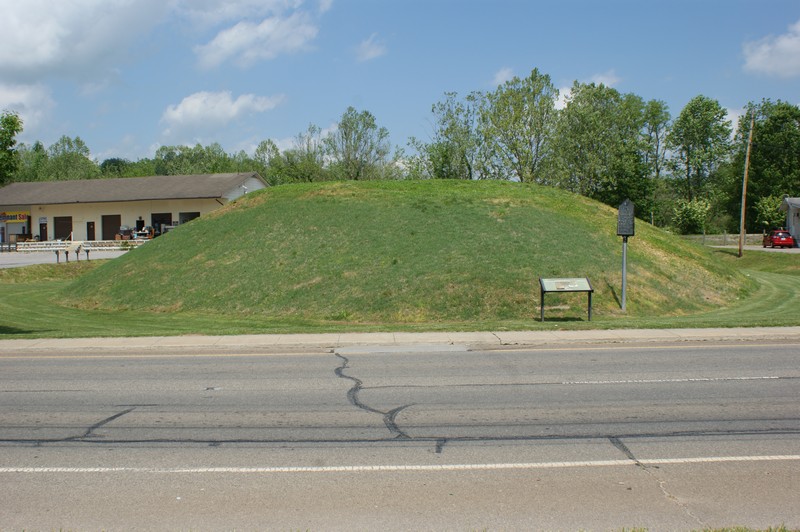Nikwasi Indian Mound
The Nikwasi Indian Mound is the last remnant of a Cherokee town of the same name which once stood here on the banks of the Little Tennessee River. The Cherokee Nation towns were divided into Lower, Middle, and Over the Hill Towns. The Middle Towns, of which Nikwasi was one, were found every few miles along the Little Tennessee and its tributaries from its headwaters to the Smokies. While the mound was probably built during the earlier Mississippian Culture, it was the spiritual center of the area. A Council House, or Town House, used for councils, religious ceremonies, and general meetings, was located on top the mound, and the ever-burning sacred fire, which the Cherokee had kept burning since the beginning of their culture, was located there. Thus the mound was a most revered site. The town of Nikwasi was a "white", or peace, town. It was believed that the Nunne'hi, the spirit people, lived under this mound. When James Mooney was studying the legends of the Cherokee for the Smithsonian in 1887 - 1890, he was told the legend of these Spirit Defenders of Nikwasi by an old medicine man name Swimmer. Today it stands as a stately and silent reminder of a time, a culture, and a people of a bygone era. The mound has never been excavated for any reason, agricultural, archeological, or commercial. It stands at near its original height. One cannot truly experience the mound by merely driving by. One must stand at the base to appreciate the size and grace of Nikwasi, and try to envision a time from the past when the mound was surrounded not by busy 21st century traffic and businesses, but by fields, orchards, and a people who lived in complete harmony with the land and the river. The Eastern Band of the Cherokee respectfully request that no climbing on the mound so that it may be preserved. Please feel free to visit the mound and walk around it, but please honor the Cherokee's request.

Nikwasi Indian Mound
The Nikwasi Indian Mound is the last remnant of a Cherokee town of the same name which once stood here on the banks of the Little Tennessee River. The Cherokee Nation towns were divided into Lower, Middle, and Over the Hill Towns. The Middle Towns, of which Nikwasi was one, were found every few miles along the Little Tennessee and its tributaries from its headwaters to the Smokies. While the mound was probably built during the earlier Mississippian Culture, it was the spiritual center of the area. A Council House, or Town House, used for councils, religious ceremonies, and general meetings, was located on top the mound, and the ever-burning sacred fire, which the Cherokee had kept burning since the beginning of their culture, was located there. Thus the mound was a most revered site. The town of Nikwasi was a "white", or peace, town. It was believed that the Nunne'hi, the spirit people, lived under this mound. When James Mooney was studying the legends of the Cherokee for the Smithsonian in 1887 - 1890, he was told the legend of these Spirit Defenders of Nikwasi by an old medicine man name Swimmer. Today it stands as a stately and silent reminder of a time, a culture, and a people of a bygone era. The mound has never been excavated for any reason, agricultural, archeological, or commercial. It stands at near its original height. One cannot truly experience the mound by merely driving by. One must stand at the base to appreciate the size and grace of Nikwasi, and try to envision a time from the past when the mound was surrounded not by busy 21st century traffic and businesses, but by fields, orchards, and a people who lived in complete harmony with the land and the river. The Eastern Band of the Cherokee respectfully request that no climbing on the mound so that it may be preserved. Please feel free to visit the mound and walk around it, but please honor the Cherokee's request.
